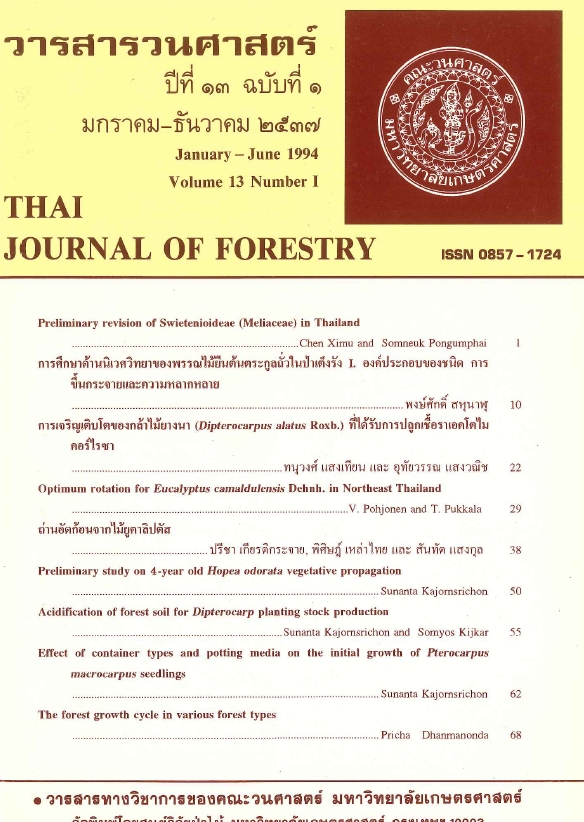THE FOREST GROWTH CYCLE IN VARIOUS FOREST TYPES
Main Article Content
บทคัดย่อ
Determination of the process and rate of revegetation by using data on tree density, basal area, H* (a coefficient indicating the ideal maximum tree height) and above-ground biomass were investigated in dry dipterocarp forest (DDF), hill evergreen forest (HEF), evergreen broadleaved (EBF) and EBF (S, M and A types). The results revealed that the forest growth cycle (the gap phase, the building phase and the mature phase) were estimated to be 0-60, 60-122, 122-244 years; 0-50, 50-100, 100-200 years; 0-42, 42-70, 70-180 years for DDF, HEF and all EBF types, respectively. Rapid increase in basal area, H* and high mortality of saplings were found during the gap phase. A slow increase in basal area, H* and low mortality were found during the building phase, while the mature phase was characterized by an almost saturated basal area, H* and above-ground biomass. In the case of EBF, gap indicators flourished in the gap phase, but their dominance declined in the building phase, and finally they were excluded from the mature phase. On the other hand, evergreen oaks steadily increased their dominance as time passed. No gap species occured in the DDF and HEF.
Downloads
Article Details

อนุญาตภายใต้เงื่อนไข Creative Commons Attribution-NonCommercial-NoDerivatives 4.0 International License.
ข้าพเจ้าและผู้เขียนร่วม (ถ้ามี) ขอรับรองว่า ต้นฉบับที่เสนอมานี้ยังไม่เคยได้รับการตีพิมพ์และไม่ได้อยู่ในระหว่างกระบวนการพิจารณาตีพิมพ์ลงในวารสารหรือสิ่งตีพิมพ์อื่นใด ข้าพเจ้าและผู้เขียนร่วม (ถ้ามี) ยอมรับหลักเกณฑ์และเงื่อนไขการพิจารณาต้นฉบับ ทั้งยินยอมให้กองบรรณาธิการมีสิทธิ์พิจารณาและตรวจแก้ต้นฉบับได้ตามที่เห็นสมควร พร้อมนี้ขอมอบลิขสิทธิ์ผลงานที่ได้รับการตีพิมพ์ให้แก่วารสารวนศาสตร์ คณะวนศาสตร์ มหาวิทยาลัยเกษตรศาสตร์ กรณีมีการฟ้องร้องเรื่องการละเมิดลิขสิทธิ์เกี่ยวกับภาพ กราฟ ข้อความส่วนใดส่วนหนึ่ง หรือ ข้อคิดเห็นที่ปรากฏในผลงาน ให้เป็นความรับผิดชอบของข้าพเจ้าและผู้เขียนร่วม (ถ้ามี) แต่เพียงฝ่ายเดียว และหากข้าพเจ้าและผู้เขียนร่วม (ถ้ามี) ประสงค์ถอนบทความในระหว่างกระบวนการพิจารณาของทางวารสาร ข้าพเจ้าและผู้เขียนร่วม (ถ้ามี) ยินดีรับผิดชอบค่าใช้จ่ายทั้งหมดที่เกิดขึ้นในกระบวนการพิจารณาบทความนั้น”


